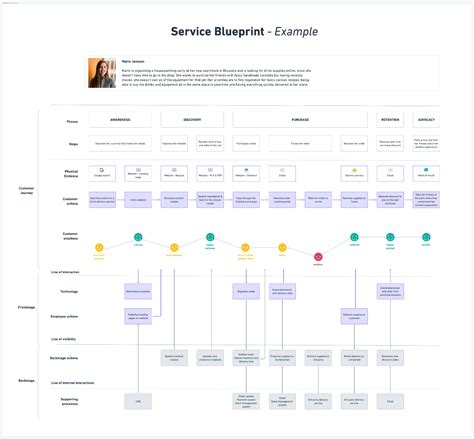

How to Build a Mind-Blowing Service Blueprint in 5 Simple Steps
Steps to Create a Service Blueprint
- Define the Service and Customer Journey: Delve deep into the customer’s needs and wants. Map out every touchpoint, from pre-service to post-service.
- Identify Key Actors and Technologies: Pinpoint all individuals, departments, and systems involved in delivering the service. Highlight the technological tools and interactions.
- Develop the Process Flow: Visualize the sequence of activities and interactions that make up the service delivery. Use swimlanes to represent each actor’s role.
- Map the Evidence and Interfaces: Determine the physical or digital evidence of each step, such as receipts, emails, or website interfaces. Highlight the customer’s interactions with these interfaces.
- Analyze and Optimize: Scrutinize the blueprint to identify areas for improvement, such as bottlenecks, gaps, or unnecessary steps. Implement changes to enhance the customer experience.
Uncover Customers’ Deepest Desires
According to the 2022 Customer Experience Index, 75% of customers expect a personalized experience, and 68% say it’s essential for loyalty. A service blueprint empowers you to tailor your offerings to each customer’s unique needs and wants.

Innovation at Your Fingertips
By analyzing the service blueprint, you can uncover opportunities for new applications. For instance, integrating AI-powered chatbots to streamline customer interactions or using data analytics to predict customer preferences.
Avoiding the Service Blueprint Blues: Common Mistakes
- Ignoring the Customer Perspective: Failing to put yourself in the customer’s shoes can lead to a blueprint that misses crucial touchpoints and pain points.
- Lack of Collaboration: Excluding key stakeholders from the process can hinder the accuracy and effectiveness of the blueprint.
- Focusing on the Process, Not the Outcome: Getting lost in the details of the service delivery can distract from the ultimate goal of enhancing the customer experience.
Tables for Blueprint Success
| Actor | Role | Evidence |
|---|---|---|
| Customer | Requests service | Phone call, email |
| Agent | Processes request | Case management system |
| Manager | Approves request | Signed document |
FAQs for Blueprint Brilliance
- Can I use a service blueprint for any industry? Yes, service blueprints are applicable to any industry that delivers a service to customers.
- How often should I update my service blueprint? Regularly, to keep pace with evolving customer expectations and technological advancements.
- Who should be involved in creating a service blueprint? A cross-functional team representing all stakeholders, including customer service, operations, and marketing.
- Is there a specific software required? While specialized software can assist in creating blueprints, it’s not always necessary. Visual mapping tools or even pen and paper can suffice.
- How do I analyze the blueprint for improvement? Examine the touchpoints, interactions, and processes for areas of friction, inefficiency, or opportunity.
- Can service blueprints be used for employee training? Yes, they can serve as valuable training materials to help employees understand their roles and the overall service delivery process.
- How do I ensure the blueprint reflects the customer’s perspective? Conduct customer interviews, surveys, and observations to gather insights into their wants, needs, and pain points.
- Is a service blueprint the same as a process map? While similar, a service blueprint provides a more comprehensive view of the service delivery, including customer touchpoints and interactions.










